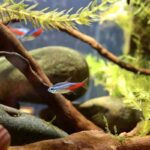Nose tetras comprise several popular tetra species recognized by their elongated cone-shaped snout protruding forward from tiny heads. When kept in schools of 8 or more, they exhibit delightful behaviors including synchronized schooling displays and playful chasing. But which fish species properly mix with them as tank mates? Read the considerations below to select suitable companions for your nose tetra school.
Nose Tetra Care Needs and Behavior
To identify appropriate tank mates, we must first understand key aspects of nose tetras’ care and temperament:
• Size – Remain fairly small, just 1.5-2 inches long as adults
• Preferred Aquarium Conditions – Require mildly acidic and soft water with warm temperatures between 72-82° F
• Schooling Behavior – Feel safest when kept in moderately sized groups of 8 individuals or more
• Activity Level – Quite energetic, darting swiftly about the tank throughout all water layers
• Diet – As omnivores, they accept a wide variety of foods including live, freeze-dried, flake and pellet
• Sensitivity – Prone to stress from bullying tank mates or water parameter fluctuations
Selecting Suitable Tank Mates
Knowing nose tetras prefer warm, soft water plus create lots of frenetic movement, certain community fish make compatible options while others spell trouble. Excellent tank mate choices include:
• Other small, peaceful schooling tetras like ember tetras, bloodfin tetras, rummy nose tetras, glowlight tetras etc. Seeing their own kind relaxes them.
• Small rasboras (harlequin, chili) and danios (zebra, pearl) that occupy upper levels, avoiding bottom territories
• Dwarf cichlids like rams that aren’t overly aggressive and do well in soft water
• Smaller catfish, including otocinclus for algae control and pygmy corydoras for activity at lower tank levels
• Invertebrates like nerite snails, amano shrimp, vampire shrimp
Nose Tetra Incompatibility Caution Areas
On the flip side, avoid mixing nose tetras with:
• Extra large or very small fish – increases chances of bullying or eating smaller tankmates
• Known fin nippers like tiger barbs, serpae tetras – will shred long nose tetra fins
• Big cichlids who rule tanks aggressively, seeing all other fish as prey or threats
• Bottom feeders requiring different water chemistry like common plecos
• Predatory fish species who will target them as food sources
In Summary
Target fish sharing preferences for warm, acidic water plus schooling behaviors when selecting nose tetra tank mates. Similar small tetras, rasboras, dwarf cichlids, and nano catfish make fine companions. But steer clear of species bullying them, destroying fins, or eating small fish to sustain nose tetra health and happiness! Proper compatibility allows both nose tetras and tankmates to showcase natural behaviors safely.






A person essentially help to make seriously articles I would state. This is the very first time I frequented your web page and thus far? I amazed with the research you made to create this particular publish incredible. Excellent job!